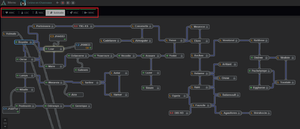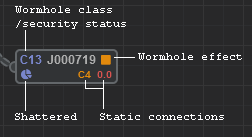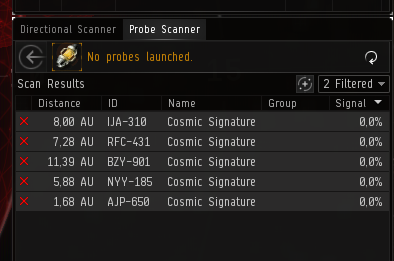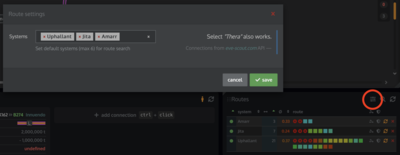Difference between revisions of "EVE UNI Mapper"
(→Adding systems and connections: Clean up) |
(Slight section organization adjustment) |
||
| Line 37: | Line 37: | ||
* If signatures are enabled the wormhole will show its connected WH signatures at its ends. | * If signatures are enabled the wormhole will show its connected WH signatures at its ends. | ||
| − | == | + | == Managing information == |
| − | The main purpose of the mapper is to share information. If enabled, Pathfinder will automatically add systems and connections you jump into from systems already noted on the map. However, the rest of the information about the systems and details of the connections have to be entered by the players. | + | The main purpose of the mapper is to share information. If enabled, Pathfinder will automatically add systems and connections you jump into from systems already noted on the map. However, the rest of the information about the systems and details of the connections have to be manually entered by the players. |
| − | + | === Creating maps === | |
| + | |||
| + | In addition to the preexisting corporation maps you can also host private maps. To create a map just click the "add +" button on top right corner. Private maps can be shared with limited number of other players. | ||
=== Adding signatures === | === Adding signatures === | ||
| Line 135: | Line 137: | ||
When considering jumping through a wormhole that is already marked EOL, look at the last update time of the particular connection. You can do this by hovering your mouse over the "ship" icon in the top right corner of the map grid. When you do this, tooltips will appear over every wormhole connection, which will tell you when the connection was first created (the first line) and when the connection was last updated (the second line). If last update time is 2 to 4 hours of a connection already marked EOL, give additional consideration whether you jump through and how long you decide to stay. | When considering jumping through a wormhole that is already marked EOL, look at the last update time of the particular connection. You can do this by hovering your mouse over the "ship" icon in the top right corner of the map grid. When you do this, tooltips will appear over every wormhole connection, which will tell you when the connection was first created (the first line) and when the connection was last updated (the second line). If last update time is 2 to 4 hours of a connection already marked EOL, give additional consideration whether you jump through and how long you decide to stay. | ||
| − | |||
| − | |||
| − | |||
| − | |||
| − | |||
| − | |||
== Shortcuts == | == Shortcuts == | ||
Revision as of 19:40, 9 October 2021
Pathfinder is a free and open-source wormhole mapping tool. This tools allows groups of players to share mapped wormhole connections, intel and cosmic signature information.
Mapping is important to coordinate campuses' scanning and exploration and is vital for Wormhole Campus to ensure they have full knowledge of nearby wormholes. EVE University hosts a private Pathfinder for its members at https://pathfinder.eveuniversity.org/ Pathfinder was introduced in November 2019 as a replacement for our old EVE-Wspace tool.
Accessing the mapper
To view and contribute to the mapper, you need to log in via SSO:
- Go to https://pathfinder.eveuniversity.org/
- Use SSO login and log in with your EVE Online account. The logging in is done through EVE Online servers and is safe.
First thing you will want to do after logging in, is to select your required map. This will usually be your campus map, but you may also have a personal or shared map.
To do this, click the respective map at the top of the map screen.
- LSC - Low Sec Campus Map
- NSC - Null Sec Campus Map
- HSC - High Sec Campus Map
- WHC - Wormhole Campus Map
- AMC - Amarr Mining Campus Map
Reading the map
The map is made of systems of any security level, and the connections in between them. On the map it will show some of their information in compact form. To see the full set of information known about the system, select it on the map and look at the adjacent panels.
Connections between systems will change shape and color depending on their properties. These are user-defined and rely upon capsuleers to specify this information by right-clicking on the connection on the map.
- Wormhole size limit is indicated by letter on the wormhole. Additionally small and medium wormholes have dashed lines. For example, an encircled "L" specifies a large connection.
- Reduced and critical mass wormholes have yellow and red cores.
- End-of-life (EOL) wormhole connections have purple outlines.
- If signatures are enabled the wormhole will show its connected WH signatures at its ends.
Managing information
The main purpose of the mapper is to share information. If enabled, Pathfinder will automatically add systems and connections you jump into from systems already noted on the map. However, the rest of the information about the systems and details of the connections have to be manually entered by the players.
Creating maps
In addition to the preexisting corporation maps you can also host private maps. To create a map just click the "add +" button on top right corner. Private maps can be shared with limited number of other players.
Adding signatures
First make sure you have the correct system selected. Signatures can be added one by one or imported in bulk. It is recommended to import them in bulk as it is much faster and easier to keep the system up-to-date.
To add single signature manually, follow these steps:
- Make sure you have the correct system selected.
- Click the + button in the top right corner of signatures panel.
- Add the Signature ID (the three letters shown in your signatures list. For example, if the ID is RFA-139, you just add RFA).
- Select which type of signature it is.
- Add in the description.
- Press the + button on this row of information.
To quickly bulk import signatures, follow these steps:
- Make sure you have the correct system selected.
- Select a signature in your scan window in-game, or select all signatures (CTRL+A).
- Copy the signatures (CTRL+C).
- Paste the signatures (CTRL+V).
This updates those signatures, or adds them if they don't exist.
"Lazy delete" option can be used when you import all the signatures in a system. With lazy delete all old signatures that are not included in your new bulk import will be deleted. This is great for completely refreshing a system and clearing out any old signatures.
There is also a more detailed signature reader. To open it click the clipboard icon at the top right corner of the signatures panel. This works the same way as simply pasting the signatures to Pathfinder but with a preview window.
Preexisting signatures can also be edited or deleted in the signatures panel. Simply click the attribute you want to change.
Adding systems and connections
There are multiple different ways to add systems and connections:
- The most convenient is using the tracking to automatically add systems within Pathfinder as you jump into them. The types of systems can be limited by the map maintainer. If the map scope is set to "all", all connections will be automatically added; if the map scope is set to "wormholes", only wormhole connections are added; and if the scope is set to "stargates" only stargate connections are added. If the scope is set to "none" no connections are automatically added. The pilot tracking has it flaws; Jump cloning, getting podded or just opening a different map may add non-existing connections to the map.
- Instead, you may manually create systems on the map. Right clicking a system allows you to add a connection to it in the drop down.
After a system has had another system added to it with a wormhole connection this can be linked to a signature in that system. Simply click the "leads to " attribute on the WH signature and select the corresponding system once the new system is present. Setting this will automatically add mass and size limit info on the connection if the wormhole was not K162.
Wormhole connection health should be subsequently verified and set by right clicking the wormhole connection. This way you can set the mass criticality and end of lifetime of the connection. EOL connections are automatically deleted 4h 15m after the status is set. The "preserve mass" option is for informing other map users to not waste mass of this wormhole.
Practical example
Here is a practical example on how to add scan data to Pathfinder:
- You arrive to the system of Octanneve. After making sure you are safe you start to scan the system. The first mapper-related thing you should do is to check if the mapper contains up-to-date information on cosmic signatures. If you are lucky, all the signatures are already mapped and you don't need to scan at all. To do this, select the system in which you are and look at the "Signatures" panel below the map.
- Start by enabling the "lazy 'delete' signatures" option at top right corner. With this option enabled you can paste new full signature data of the system and all the signatures that are not present anymore will be deleted from Pathfinder. Note that this option will automatically disable itself after every scan so you will need to re-enable it every time you need it.
- Open the probe scan window in-game.
| Select the probe scanner window, select all signatures with CTRL+A and copy them with CTRL+C. |
- Pay attention to the filters you use. Depending on the campus you are in, information on anomalies in known space is rarely useful and just adds unnecessary noise. On the other hand, in wormhole space the information on anomalies can be very important.
- Go back to Pathfinder window and CTRL+V to add the info on signatures. Now you will easily see if any of the old signatures is still present in system. There is no need to scan those again so you will be able to scan faster by taking advantage on the old scanning information in Pathfinder.
- Once you have scanned all signatures you can add the scanned data in Pathfinder the same way. Select signatures with CTRL+A, copy them with CTRL+C and paste them in Pathfinder with CTRL+V.
In this example you find a wormhole in system. You, being a good explorer, will of course map it:
- Warp to the wormhole at a distance so you are not immediately uncloaked.
- Once you are on grid with the wormhole you will be able to see the type of the wormhole on your overview. All wormholes have not very useful "K162" on their "out" end and a more useful name on the "in" end. As such, the "K162" can be present for any class of wormhole. Other types are usually associated to specific classes and wormhole sizes.
- In this example the "in" end is in this system. Add this information to the Pathfinder for the specific signature that you warped to.
- In the signatures panel click the red "unknown" text in the "type" column of the wormhole. Write in the name of the wormhole.
- With the exception of the "K162" wormhole types, knowing the type of the wormhole will reveals the ship size limit, mass limit and what kind of system is on the "out" end of the wormhole.
- To map the connection to the specific system, you jump through the wormhole. If you have tracking enabled in Pathfinder the destination system is added and connected in the map automatically. If the tracking is not enabled you can right click the system you were in and select "add system" to add a system.
- Add a bookmark for the wormhole connection in the respective campus bookmark location. Some campuses may require a specific scheme for naming bookmarks.
- Now connect the previous signature to the wormhole. Make sure your now previous system is still selected, then click the "leads to" attribute of the wormhole in the signatures panel. The drop down menu will already contain the newly connected system for you to select. This information is useful later when the signature has gone away. When next person comes and removes the signature that is no longer mapped the wormhole connection is also deleted without extra input.
Some mapping schemes may also require you to add a name for the connected wormhole system. This is based on the bookmarking scheme that is used by the respective campus to make it easier to follow bookmark trails without the need to look at the mapper in every system on the path. Double click a system in the mapper to open the dialog where you can add or update the name to include the name from the bookmark (e.g. "2 B1 Aldrat").
Keeping content updated
Even after you have fully mapped the respective systems in your area of interest, the other part of Pathfinder is keeping it continuously updated.
Signature updates
As you travel through systems on the map, establish the habit of updating signatures as you warp through the system, even if you have not scanned them down yet. The panels within Pathfinder differentiate when a given signature was first created and when it was last updated. When bulk importing signatures using the "Lazy 'delete' signatures" method, your updates will automatically remove signatures no longer present in the system. Adding unknown signatures, particularly when you may not have time to scan them down, will prompt others to investigate. More importantly, if Pathfinder has specific information about a particular signature but it's unidentified in your local list, pasting updated signatures into Pathfinder will retain the specific information and will not overwrite it with unknown values.
Connection End of Life
Pay attention to the lifetime of wormhole connections each time you travel through them. When you notice that the connection is approaching end of line due to its visual differences / descriptive text of the wormhole, go into Pathfinder and mark the connection between the respective systems as "EOL". When doing this, the connection will turn purple on the map, and the connection will be automatically removed from Pathfinder once a 4 hour timer expires.
When considering jumping through a wormhole that is already marked EOL, look at the last update time of the particular connection. You can do this by hovering your mouse over the "ship" icon in the top right corner of the map grid. When you do this, tooltips will appear over every wormhole connection, which will tell you when the connection was first created (the first line) and when the connection was last updated (the second line). If last update time is 2 to 4 hours of a connection already marked EOL, give additional consideration whether you jump through and how long you decide to stay.
Shortcuts
- Spacebar + mouse allows dragging the map.
- Holding CTRL allows you to select multiple systems or connections on the map.
Personalizing
You can change certain aspects of how information is presented or handled on the mapper. These settings will only apply to you.
The map setting can be changed by clicking the "map" button on top right corner of Pathfinder. This opens side bar with following options:
- Settings - Only available for the map maintainer.
- Grid snapping - Snaps systems into grid when you move them.
- Magnetizing - Causes systems to push at each other to prevent them from overlapping.
- Signatures - Shows signature info of the wormhole connections on map.
- Compact - Hide/show pilot names on the map.
The panels below map can be rearranged by dragged them from their corners.
In addition, the mapper can look up the shortest routes to your favourite locations from a selected system. Use Routes/settings to add and save these connections (see screenshot).




